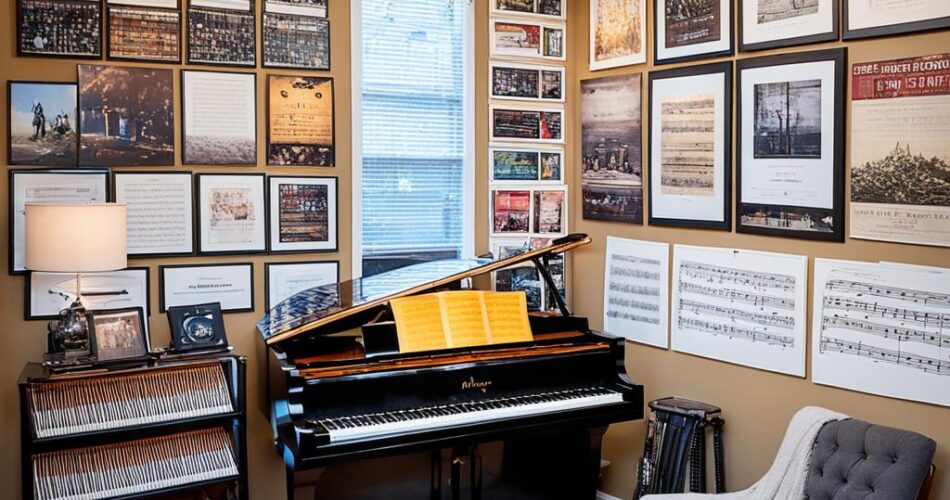Do you dream of a space where your musical talents can grow? A well-designed music room is the perfect solution. It’s great for both new artists and seasoned musicians. Let’s look at some cool music room ideas that mix style with function.
Home music studios are getting more popular, with 15 out of 17 tips focusing on design and setup. A well-planned music space can change how you experience music. Soundproofing and smart storage are key to making the perfect room.
Music room design is more than just about sound quality. It’s about making a place that inspires you. Three tips suggest adding artistic touches to spark creativity. Think about adding bright wall art, motivational quotes, or a small stage.
When setting up your music gear, think about comfort. One tip recommends having a cozy bed for resting between rehearsals. A well-lit room is also important for reading sheet music, so don’t forget about lighting.
Are you ready to start your music room project? Let’s explore the key elements for a space where music and creativity flourish.
Understanding the Purpose of Your Music Room
Creating a dedicated space for music can change your home into a place full of creativity. Whether it’s for a rehearsal space, band practice space, or a music listening room, knowing what you want is crucial. Let’s look at the different types of music rooms and what they need.

Practice Space Considerations
A rehearsal space or band practice space needs a lot of thought. It should have enough room for your instruments, be soundproof, and have places to store things. Think about putting in racks and shelves for your gear to stay organized and within reach.
Performance Area Requirements
For a performance area, consider a stage-like setup and seats for the audience. This room should fit your band and any guests. Adding good lighting and a small sound system can make your performances feel like a real show.
Listening Room Essentials
A music listening room is all about comfort and great sound. Spend on a good audio system and comfy seats. Adding acoustic treatments can make listening even better, like a personalized spot for entertainment.
| Room Type | Key Features | Equipment Needed |
|---|---|---|
| Practice Space | Soundproofing, Storage | Instrument Racks, Music Stands |
| Performance Area | Stage Setup, Seating | Lighting, Sound System |
| Listening Room | Comfort, Acoustics | Quality Speakers, Comfortable Chairs |
Your music room can be many things. It can be a home recording studio or a place for different music practice rooms. By knowing what you need, you can make a space that matches your love for music.
Determining the Ideal Size and Layout
Start by measuring your space for the best music room layout. Think about the space needed for instruments, equipment, and moving around. A good musician workspace is both functional and comfortable. For instance, a listening room could be 27 feet long, 17 feet wide, and have an 11-foot ceiling.

When planning your rehearsal space, consider the music you play. Genres with amplifiers need more space than acoustic music. If you’re setting up a home studio, think about having separate areas for recording. This setup improves sound quality and lets you record multiple tracks at once.
Good flow is crucial in any music room design. Make sure you can easily get to all your gear and storage spots. This smart use of space can lead to creative ideas in your music room, just like in small kitchens.
Think about these points for your music room layout:
- Room dimensions and shape
- Number of musicians
- Instrument sizes and quantities
- Equipment placement
- Storage needs
The perfect size and layout for your music room depend on your needs. Whether it’s for practicing, performing, or recording, a well-thought-out design will boost your music-making and efficiency.
Optimizing Acoustics for Superior Sound Quality
Creating the perfect acoustics in music rooms is key for top-notch sound quality. The shape and size of your space greatly influence how sound moves and bounces back. Rectangular rooms usually spread sound evenly, and avoiding parallel walls helps stop standing waves.
Room Shape and Size Impact
The size of your music room changes how sound behaves. Big rooms are better for low sounds, but small ones might need more sound treatment. Use the Bolt Area Ratio to plan your room for the best sound spread.

Surface Materials and Sound Absorption
It’s important to balance hard and soft surfaces for great acoustics. Soft things like carpets and curtains soak up sound, cutting down on echoes. Hard surfaces bounce sound back, which can be useful for a lively sound.
Ceiling Height Considerations
High ceilings help sound waves spread out more. If your ceiling is low, think about adding acoustic panels or diffusers to control sound reflections. The aim is to make an acoustic space that makes music sound better.
- Use acoustic panels for targeted sound absorption
- Install bass traps in corners to manage low frequencies
- Employ diffusers to scatter sound waves evenly
- Consider soundproofing techniques for noise control
By focusing on these areas of acoustical treatment, you can make a music room with amazing sound quality. This is great for practicing, performing, or recording music.
Soundproofing Techniques for Noise Control
Creating a soundproof music room is key for musicians and music lovers. It ensures you can practice without distractions and keeps noise out. Let’s look at some top soundproofing methods and materials for better sound insulation.

Begin with the walls, a key area for sound to move through. Add thick soundproofing materials like mass-loaded vinyl or acoustic panels to soak up sound waves. For even better results, stack drywall with Green Glue in between. This setup greatly cuts down on sound escaping.
Floors and ceilings are also vital for soundproofing. Put cork underlayment or rubber mats under your flooring to soften vibrations. For ceilings, hang acoustic tiles or add a soundboard layer to stop sound from moving between floors.
Doors and windows can let sound in easily. Choose solid-core doors with weather stripping and door sweeps to block gaps. For windows, go for double-glazed or laminated glass for top sound insulation. Soundproof curtains can also help reduce noise.
- Use fiberglass insulation in wall cavities
- Install bass traps in room corners
- Add diffuser panels to improve sound quality
- Seal any air gaps or cracks with acoustic caulk
Using a mix of soundproofing methods works best. By applying these tips, you’ll make a perfect space for making music and enjoying it. This way, you keep peace with those around you.
Essential Furniture and Equipment Selection
Choosing the right music room furniture and gear is key to a great space. It’s important to have comfortable seating and smart ways to store your instruments. Each piece helps make your music time better.
Seating Options for Comfort and Posture
Get adjustable chairs or stools to keep your back straight while playing. For chilling out, pick seats that are comfy and let you dive into the music. The Edifier R1000T4 active speakers, priced around $70, are loved by 77% of Amazon buyers. They’re a smart choice for your music room.
Instrument Storage Solutions
Keeping your gear safe is crucial. Use wall racks or stands for guitars and other stringed instruments. For smaller items, consider shelving or cabinets. Clear bins are great for keeping cables, picks, and other essentials tidy.

Audio Equipment Essentials
Make sure your music room has top-notch audio gear. The Marantz CD6007 CD player, about $450, is known for its clear sound. If you’re watching your budget, the Panasonic SC-HC302EB-K Micro Hi-Fi system is a good deal at around $170. Don’t forget music stands, amps, and mic stands for recording.
Arrange your furniture and gear so it’s easy to move around in your music room. Check regularly to make sure your storage is working well. This keeps your space organized and inspiring.
Lighting Design for Ambiance and Functionality

Music room lighting is key to creating the perfect vibe for creativity and performance. A smart lighting plan boosts both the feel and use of your space. Let’s dive into some cool lighting ideas for music rooms to spark your next project.
For music room lighting, being versatile is essential. Choose lights that you can adjust to change the brightness. This lets you switch from bright task lighting for reading music to softer mood lighting for chilling or playing.
Here are some lighting ideas for your music room:
- Dimmable recessed lights for overall illumination
- Focused task lighting near instrument areas
- Ambient floor lamps for a cozy vibe
- Music-themed lighting fixtures as statement pieces
Did you know 70% of music rooms use an ambient lighting system? This shows how important it is to make a calm atmosphere while improving sound quality. With smart lighting controls, you can easily change the mood for different activities.
For a special touch, check out music-themed lighting. Guitar-shaped wall sconces or drum pendant lights can bring personality to your space and be useful. These unique lights not only light up the room but also spark conversations.
Effective lighting in music rooms is more than just looking good. It helps you read music, play, and enjoy your instruments better. By mixing task lighting, ambient lighting, and decor, you’ll make a space that looks great and works well for all your music needs.
Music Room Ideas: Inspiring Decor and Themes
Turn your music room into a place that sparks creativity. Let’s dive into exciting ideas to make your space special and boost your musical passion.
Wall Art and Visual Inspirations
Music-themed wall art can bring your room to life. Hang up sheet music of your favorite tunes or concert posters. A gallery wall with 12 framed album covers adds a nostalgic feel. For smaller rooms, a music wall concept is perfect.

Color Schemes for Creative Stimulation
Pick colors for your music room that spark creativity. Bright colors and decor with patterns can energize your space. A bold choice is a bubblegum-hued piano next to a music nook.
Personalized Touches and Memorabilia Display
Show off your music memorabilia to make your space unique. Add built-in shelves for small instruments or a wall unit for records. Mix style with practicality by adding a wine storage area near your piano.
| Theme | Key Elements | Mood |
|---|---|---|
| Vintage Vibes | Retro posters, vinyl records | Nostalgic |
| Nature Retreat | Potted plants, earthy tones | Serene |
| Industrial Edge | Exposed brick, metal accents | Modern |
| Genre-Inspired | Jazz art deco, rock leather | Expressive |
| Futuristic Fun | LED lighting, sleek design | Innovative |
Remember to think about both looks and sound quality. Concrete floors help with sound reflection, while carpet absorbs sound. A solid core door helps keep the noise in. With these tips, your music room will be a place that sparks creativity and celebrates your musical journey.
Maximizing Storage and Organization
Getting your music room organized is crucial for a space that’s both useful and inspiring. Start by putting up shelving for records, CDs, and sheet music. Wall-mounted racks are great for guitars, saving space on the floor. Cabinets are also a good choice for keeping your audio equipment safe and clean.
Think about using space up high. Floating shelves and overhead racks make the most of every inch. Pull-out drawers and retractable stands are great for keyboards and smaller instruments. They let you reach your gear easily without taking up too much room. Aim to make a luxurious music room that looks good and is practical.
If you’re short on space, look for furniture that does more than one thing. Consider music tables that fold down and rolling racks for extra flexibility. Don’t ignore spots like under-stair areas or window seats – they can be great for extra storage. With these tips, you’ll have a tidy space that supports your music and keeps your gear safe.
